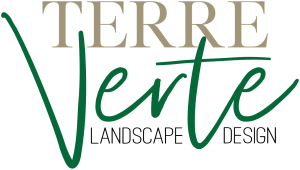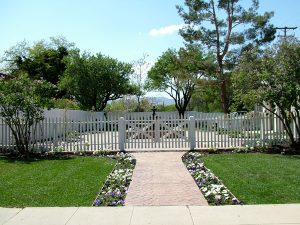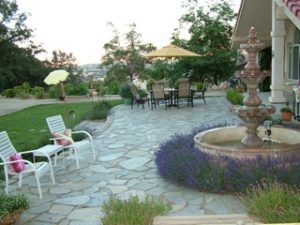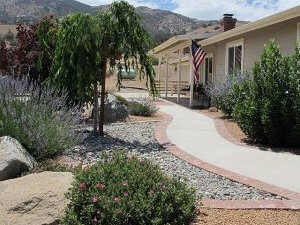One common mistakes is planting the tree too deep. Correct planting depth is essential for the long term health of the tree. Plant so that the root flare (also called the crown) is above the finished landscape grade when transplanting is complete. There are three main problems caused by planting trees too deep.
- The exchange of oxygen and other soil gases is inhibited.
- Soil covering the root flare (crown) holds moisture against the trunk and can create and environment for disease and insects to flourish.
- Irrigation water must penetrate deeper to reach active roots, increasing the likelihood that the tree will suffer from over or under watering.
Following these steps for planting will ensure that your tree has a the best possible chance of surviving, and thriving.
Dig a broad, shallow planting hole.
 Three times the width of the container or root ball would be ideal. This broad area of loosened soil makes it easier for the roots of the tree to spread out during those critical first month of growth. The depth of the hole is equally important, so go no deeper than the measurement from the root flare to the bottom of the pot. If the tree is in a large box container the best approach would be to loosen the soil in the planting area as deep as possible with a rototiller, and then dig the hole. If there is not sufficient room to go three times as wide as the box, then go as wide as the site will allow.
Three times the width of the container or root ball would be ideal. This broad area of loosened soil makes it easier for the roots of the tree to spread out during those critical first month of growth. The depth of the hole is equally important, so go no deeper than the measurement from the root flare to the bottom of the pot. If the tree is in a large box container the best approach would be to loosen the soil in the planting area as deep as possible with a rototiller, and then dig the hole. If there is not sufficient room to go three times as wide as the box, then go as wide as the site will allow.
Identify the trunk flare and flare roots.
The trunk flare is located at the base of the tree and is the point where the roots spread away from the trunk. These roots are usually at least the diameter of a pencil, and are called flare roots. These roots should be partially visible after the tree has been planted. If you can not see a little bit of the flare roots you may have to remove some soil from the root ball. It is important to expose the trunk flare, and tops of the flare roots so that you can determine the proper planting depth.
Remove the container or twine around the trunk of the tree.
Containerized trees are sometimes root bound. If you purchased a tree in this state the container may be difficult to remove. If so, it may be easier to remove the container by slitting it down the sides. Then cut through any circling roots at the base of the root ball. Ball and burlap trees will have burlap and twine or wire wrapped around the base of the trunk. Remove the twine or wire that is around the trunk and loosen the burlap. It is not necessary to remove all the burlap or wire, and doing so may injure the root ball. The burlap and twine will break down quickly after planting, and the wire is usually not going to inhibit the growth of the tree in any way.
Place the tree in a wire basket to protect it from gophers.
These can be purchased or you can make your own with chicken wire.
Place the tree in the planting hole.
 I don’t wish to be redundant, but it is so important to make sure the planting hole has been dug to the proper depth, and no more. If the hole is deeper than necessary and you have to backfill before planting, there is a good chance that the tree will settle over time. Then the tree will be susceptible to all the problems previously described. It is better to plant the tree a little high than to plant it so that the trunk flare settles below the grade of the surrounding soil. Hold the tree by the root ball, not the trunk, when placing in the hole. This will assure that the rootball stays in tact.
I don’t wish to be redundant, but it is so important to make sure the planting hole has been dug to the proper depth, and no more. If the hole is deeper than necessary and you have to backfill before planting, there is a good chance that the tree will settle over time. Then the tree will be susceptible to all the problems previously described. It is better to plant the tree a little high than to plant it so that the trunk flare settles below the grade of the surrounding soil. Hold the tree by the root ball, not the trunk, when placing in the hole. This will assure that the rootball stays in tact.
Straighten the tree.
One person should hold the tree, and another person look at it from several vantage points to confirm that the tree is straight. This is difficult to correct after the tree is planted.
Amend the soil.
Eyeball the amount of soil you removed when digging the hole and add about one third that amount of compost to the soil you are going to use to backfill. Mix it together thoroughly. Not all compost is created equal. I like ‘Bumper Crop’ by Master Gardener or ‘Acid Mix’ (also by Master Gardener) when planting conifers.
Backfill gently but firmly.
 Fill the hole one third with the amended soil and tamp it down firmly without disturbing the rootball. Water a little at this point to make sure there are no air pockets and check for settling. Fill the remainder of the hole, taking care to gently pack the soil as you go. Water thoroughly.
Fill the hole one third with the amended soil and tamp it down firmly without disturbing the rootball. Water a little at this point to make sure there are no air pockets and check for settling. Fill the remainder of the hole, taking care to gently pack the soil as you go. Water thoroughly.
Stake the tree.
In Tehachapi this is a general rule. It is the rare planting site that is not in the wind at some point in the year, so staking is a good idea. Use two stakes in conjunction with a wide, flexible tie material on the lower half of the tree. After one year remove the stakes as the tree should be rooted enough to no longer need them. The exception to this is a tree grown where relentless wind blows in one direction. In this case keeping the tree staked may help it to stay growing straight.
Mulch the base of the tree.
 Mulch is a two to four inch layer of organic matter that conserves moisture, retards weeds and moderates soil temperatures. I prefer a shredded material commonly called gorilla hair. It has no nuggets and mats together well, making it harder to blow away and making it ideal for holding slopes. Keep the mulch a few inches away from the trunk of the tree so that the trunk stays dry. Mulch piled up at the base of the tree creates a moist environment where disease and insects can multiply.
Mulch is a two to four inch layer of organic matter that conserves moisture, retards weeds and moderates soil temperatures. I prefer a shredded material commonly called gorilla hair. It has no nuggets and mats together well, making it harder to blow away and making it ideal for holding slopes. Keep the mulch a few inches away from the trunk of the tree so that the trunk stays dry. Mulch piled up at the base of the tree creates a moist environment where disease and insects can multiply.
Your newly planted tree will have the best chance to flourish with proper follow-up care.
 Keep the soil moist, but not wet. This can be determined with a moisture meter, available at garden centers for around ten dollars. The probe on the meter is placed in the root ball and will read wet, moist or dry. This takes all the guess work out of deciding how often and how long to water. Each home has microclimates that makes it near impossible to guess how long each tree should be watered for optimal growth, that is why it is so hard to get a straight answer from garden professionals. There is no pat answer, but the moisture meter is an inexpensive tool that every homeowner should have to guide them in setting up a watering schedule. After your new tree has been in the ground for a year check to see if it needs any pruning to correct shape and health of the tree.
Keep the soil moist, but not wet. This can be determined with a moisture meter, available at garden centers for around ten dollars. The probe on the meter is placed in the root ball and will read wet, moist or dry. This takes all the guess work out of deciding how often and how long to water. Each home has microclimates that makes it near impossible to guess how long each tree should be watered for optimal growth, that is why it is so hard to get a straight answer from garden professionals. There is no pat answer, but the moisture meter is an inexpensive tool that every homeowner should have to guide them in setting up a watering schedule. After your new tree has been in the ground for a year check to see if it needs any pruning to correct shape and health of the tree.






